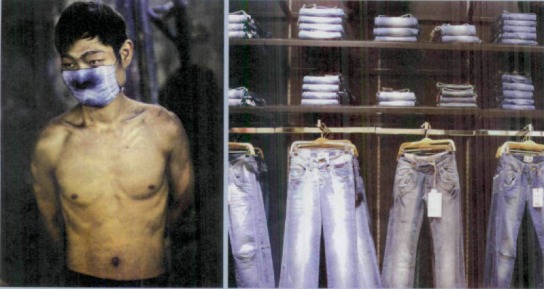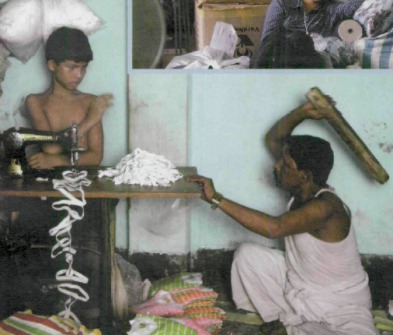What is a Sweatshop?
According to the U.S general accounting office, a sweatshop is "an employer that violates more than one federal or state labor law governing minimum wage and overtime, child labor, industrial homework, occupational safety and health, worker's compensation or industry regulation[7]." Sweatshops are located in many parts of the world. They are most highly concentrated in developing countries, but there are also domestic sweatshops right here in the U.S (so even if your label says made in the U.S.A, you should still be wary)[7]. The workers employed in sweatshops are overwhelmingly poor, and usually are immigrants, young women, or children [7]. They are forced to work "up to 20 hours a day" and undergo verbal and physical abuse and threats from the sweatshop owners[7]. Often times, workers are not allowed to use the bathroom and women are forced to take birth control and pregnancy tests, because the employers do not want to pay for a maternity leave [7].
Sweatshops and Fast Fashion
Now that we have some background information on sweatshops, it is important to know how they relate to fast fashion companies. Although there is no solid evidence for sweatshop/child labor use for EVERY fast fashion store, there have been documented cases against a lot of them, such as, Forever21, Wet Seal, and The Gap.
Forever 21
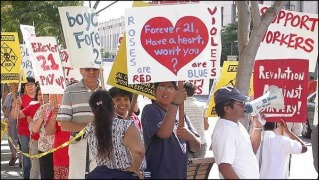
Although the majority of sweatshops can be found in developing countries, that is not always the case. Forever 21 is one of the companies which use unethical labor right here in America, in a sweatshop located in downtown L.A.[8] They had workers working ten to twelve hour days for pitiful wages, no overtime, and in horrible, dirty conditions[8]. One worker says “A lot of our factories were dirty and unsafe, with rats and cockroaches running around[8].” The Garment Worker Center has been a helpful resource for people employed by Forever 21’s sweatshops by helping them get together a public campaign and spread awareness to the public[8].
Wet Seal
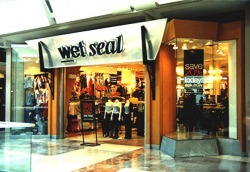
Wet Seal also has been known to have used a sweatshop in downtown L.A. In 2001, the Garment Worker Center was contacted by four sweatshop employees who claimed that had worked more than 60 hours a week making clothes for Wet Seal and other related companies[10]. The workers said they were not paid overtime and were still owed a lot of money by their employer[10]. When Wet Seal was questioned, they claimed they had no idea where the clothing was made[10].
The Gap
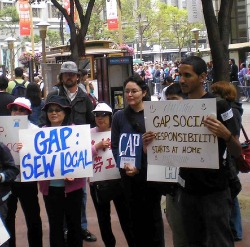
The Gap, more specifically here, Gap Kids, had been using sweatshop labor in India. The biggest problem with these sweatshops was that it was primarily child labor[11]. There were children as young as ten who said they had worked sixteen hours a day with no pay and suffered threats and abuse from their overseers[11]. One boy found there, just twelve years old “said he worked from dawn until 1 a.m. and was so tired he felt sick… But if any of the children cried, they would be hit with a rubber pipe or punished with an oily cloth stuffed in their mouths[11].
Some Good News
Forever 21 had eventually responded to the case against them, and claimed they would pay back the workers and make “steps toward to promoting greater work protection in the local garment industry[9].”
Wet Seal tried to appeal the case against them. Its president at the time claimed he had no idea where the clothes were being made, and promised to figure it out and put an end to it[10].
The leaders of the Gap fired the Indian contractor who apparently was the one wanting to use sweatshops[11]. The Gap’s president blamed the whole thing on the contractor who was unauthorized to make that decision. Gap says they “strictly prohibit the use of child labor”, withdrew all of the clothing made by the children from their stores, and are trying to make sure that all their clothing is made in an ethical way[11].
Wet Seal tried to appeal the case against them. Its president at the time claimed he had no idea where the clothes were being made, and promised to figure it out and put an end to it[10].
The leaders of the Gap fired the Indian contractor who apparently was the one wanting to use sweatshops[11]. The Gap’s president blamed the whole thing on the contractor who was unauthorized to make that decision. Gap says they “strictly prohibit the use of child labor”, withdrew all of the clothing made by the children from their stores, and are trying to make sure that all their clothing is made in an ethical way[11].
But Just Remember...
Even though some companies claim that they are against sweatshops and/or child labor use, it doesn't always mean that every article of clothing in the store has been made in a lawful and respectable way. We can see that this is true just by looking at the case against The Gap. Even though some companies claim to have changed their ways after getting slammed with a law suit, can we really be sure that they now have a clean conscience, and can we be sure we have one when we shop at their stores? Just keep in mind that it is possible that even after getting a law suit, companies may still try to outsource their labor to different places, and even though your tag may say "made in U.S.A," you can't be 100% sure you are buying ethical clothing unless it is a union label.
________________________________________________________________________
7. Feminists Against Sweatshops. http://feminist.org/other/sweatshops/sweatfaq.html
8. Garment Worker Center. PDF file here.
9. Garment Worker Center. PDF file here.
10. Nick Schou. http://www.ocweekly.com/2003-02-13/news/sweat-seal/
11. CNN article. http://www.cnn.com/2007/WORLD/asiapcf/10/29/gap.labor/
7. Feminists Against Sweatshops. http://feminist.org/other/sweatshops/sweatfaq.html
8. Garment Worker Center. PDF file here.
9. Garment Worker Center. PDF file here.
10. Nick Schou. http://www.ocweekly.com/2003-02-13/news/sweat-seal/
11. CNN article. http://www.cnn.com/2007/WORLD/asiapcf/10/29/gap.labor/
